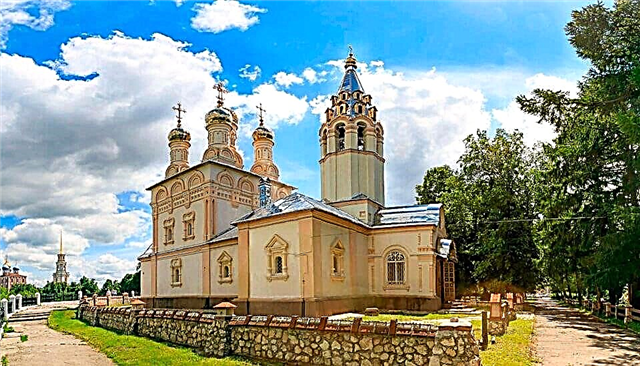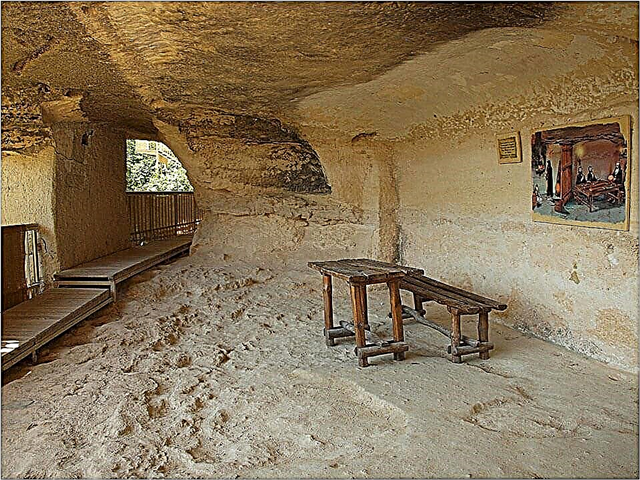Address: Russia, Moscow, st. Alexander Solzhenitsyn, 15/2
Construction date: 1791 - 1806
Shrines: a miraculous copy of the Georgian icon of the Mother of God, reliquaries with particles of holy relics, a particle of relics and a shirt (shirts) of the blessed Matrona of Moscow
Coordinates: 55 ° 44'36.8 "N 37 ° 39'36.9" E
Content:
One of the most romantic cathedrals and temples in Moscow stands on an old street, not far from the spacious Taganskaya Square. The church in the form of a Latin cross is a perfectly preserved monument of mature classicism. It pleases passers-by with perfect proportions, slender columns, a stately bell tower and a beautiful rotunda dome.

Who was Martin the Confessor
Pope Martin was born in the 7th century in Of Italy and received a good education. Then the church was one, but irreconcilable disputes about the foundations of the Christian faith were already in full swing. Pope Martin actively supported Orthodoxy. He called in Rome The local council, which condemned the views of the Monothelites.
The Roman emperor was angered by the audacious act of the church hierarch. He gave the order to the military leader Olympius to kill Pope Martin, but fate saved the lord from death. The priest was accused of secret communication with the enemies of the empire, preaching heresy, and was sent to prison for a year, which he spent on the island of Naxos.
Then a trial was held in Constantinople, at which the sick Martin was defrocked and put up for mockery by the crowd. After the proceedings, the death penalty was replaced by a reference to Crimean peninsula, to the Greek colony Chersonesos Tauride... The former Pope spent the rest of his days in a distant city.
Catholics honor Saint Martin as a martyr. In the Orthodox faith, he is considered a confessor. This is the name given to people who openly admitted themselves adherents of the Christian faith, but did not die in torment.

Temple history
Grand Duke Vasily III was crowned on the throne on the day when the church commemorated Marina the Confessor - on April 14, 1502. In memory of this solemn event, the new ruler of Russia ordered the foundation of the church of Martin the Confessor in the main city of the state. The old church stood for 300 years, and was dismantled due to dilapidation.
The stone church began to be erected in 1791 with the money of a parishioner and a wealthy tea merchant Vasily Yakovlevich Zhigarev. The construction was timed to coincide with the visit of the Holy Roman Emperor Joseph II to Russia, and the project of the building was developed by the talented architect and master of classicism Rodion Rodionovich Kazakov.
The unusual church was completed in 1806 and consecrated by the Metropolitan of Moscow Platon (Levshin). Due to its advantageous location on a hill, it has become the architectural dominant of Taganka and Zayauzia.
An interesting story happened to the temple in 1812, when Napoleon's troops were stationed in Moscow. Marshal Murat was so impressed by the beauty of the church that he set up an armed guard with an officer in front of the entrance to it. The guards defended the temple from marauders, and when the French retreated, Murat's soldiers surrendered to the Russian army.

Like other buildings in Moscow, the temple was badly damaged during a large fire. When the French left the city, a thanksgiving service was held in the church of Pope Martin in honor of the deliverance of Moscow from the enemy. The burnt facades had to be restored for more than 10 years.
Throughout the 19th century, a society for helping the poor, a parish school, an almshouse and a public school existed at the temple. The church was cold. They did not heat it, so services were held only in the warm season. In 1904, the church head, a wealthy merchant Sergei Andreevich Alexandrov donated money for which the paintings on the walls were renewed and the heating stoves were installed.
After the revolution, the ancient temple shared the fate of many shrines in Moscow. When a campaign was carried out in the country to seize church valuables, more than 14 poods of silver were taken out of the sacristy. The armed detachments took away the liturgical utensils and salaries of ancient icons. All the interior decoration of the temple, including the altar and side-by-side iconostases, was completely destroyed.
In 1931, the church was closed for worship. The empty building was occupied by a documentary film studio. Then the Book Chamber moved into the former temple, which used the premises for book funds. For a long time, the area around was surrounded by a deaf high fence. A dilapidated facade and a large inscription on the pediment with the name of the temple were visible through the cracks.

In the 1980s, the building was occupied by the computing center of one of the research institutes. When changes began in the country, the number of believers increased. The only functioning temple on Taganka - the Dormition of the Mother of God in the Potters - could not cope with the flow of parishioners. It was decided to return the Church of Pope Martin to the Church. In 1991, the miraculous image of the Georgian Mother of God was brought here.
Five years later, restorers and volunteers dismantled six reinforced concrete partitions that were built during the Soviet era. Gradually, wall paintings were restored, floors were re-covered, window sashes, heating and roofing were replaced. The iconostasis returned to the temple, which was kept in the walls for several decades Donskoy monastery... Finally, in 1998, a solemn consecration of the old church took place.
Features of the architecture
The street on which the temple stands is named after Alexander Solzhenitsyn. In Soviet times, it was called Bolshaya Kommunisticheskaya, even earlier - Kommunarov Street, and before the revolution - Bolshaya Alekseevskaya. This is one of the main streets of the Moscow Old Believers. Wealthy merchants and manufacturers diligently took care of their native land, therefore, until 1917, only one house of five floors was built here.
Now there are more tall buildings, but the graceful church of Martin the Confessor opens from afar. The bell tower and the dome seem to float above two-story stone mansions and wrought-iron fences of old estates.

Everyone who has been to this corner of the capital notes that time seems to have stopped here! The neatly restored buildings and courtyards look exactly the same as at the turn of the 18th-19th centuries.
The representative church of Martin the Confessor in Moscow resembles the famous st peter's cathedral in rome... The magical creation of Rodion Kazakov is distinguished by its bright monumentality and completeness. From the west, a three-tiered bell tower with a height of 60 m is attached to the temple. Until the 1820s, it was a separate building. A wide stone porch leads to the main entrance to the church.
The two-tiered main volume is successfully emphasized by austere Roman porticoes and a rounded dome with a light rotunda, which has a diameter of 17 m. The facades, narthex and altar apse are decorated with Doric columns, and the dome and bell tower are of Corinthian order.
Interiors and shrines
The interior of the temple makes the same strong impression as the building itself. Candles are burning under quiet vaults, and gilding sparkles. Visitors can see the ancient carved iconostasis, which was located in Moscow during the years of persecution of believers. Museum of architecture... The altar wall has the original form of a triumphal gate and is dedicated to the victory of Russia over the French.

Inside, there are original wall paintings from the early 19th century by Antonio Claudo. The frescoes in the Italian style differ from what is customary to depict in Orthodox churches. Under the drum one can see plots unusual for Orthodoxy - the apostle Peter, the prophet Moses and many figures around.
The main shrine of the temple is considered to be a list with the miraculous icon of the Mother of God of Georgia. In addition, the church contains relics with particles of the relics of Christian saints and a funeral shirt in which Blessed Matrona was buried.
Useful information for pilgrims and tourists
The doors of the temple are open to everyone from morning to evening.Church services are held daily at 8:00 and 17:00. A Sunday school has been established at the church, where children of parishioners study.
The main throne is dedicated to the Ascension of the Lord. The baptismal church with a baptistery is located in the crypt, below ground level. There is a natural spring under the church of Martin the Confessor, the water of which is used for church rituals.

How to get there
The temple is located in the city center, on Alexander Solzhenitsyn Street, 15/2. The church is easily accessible on foot from the Taganskaya and Marksistskaya metro stations.











